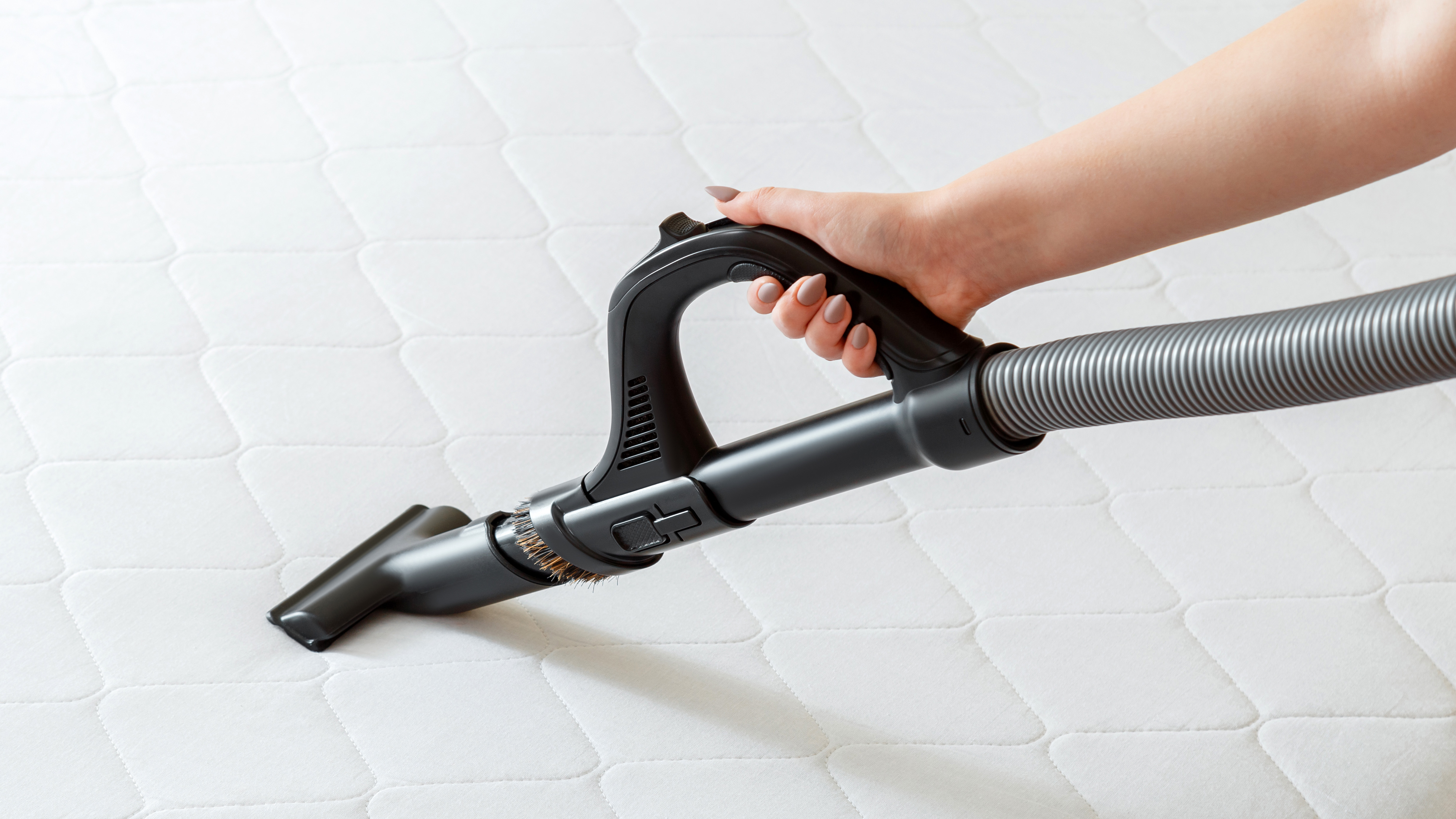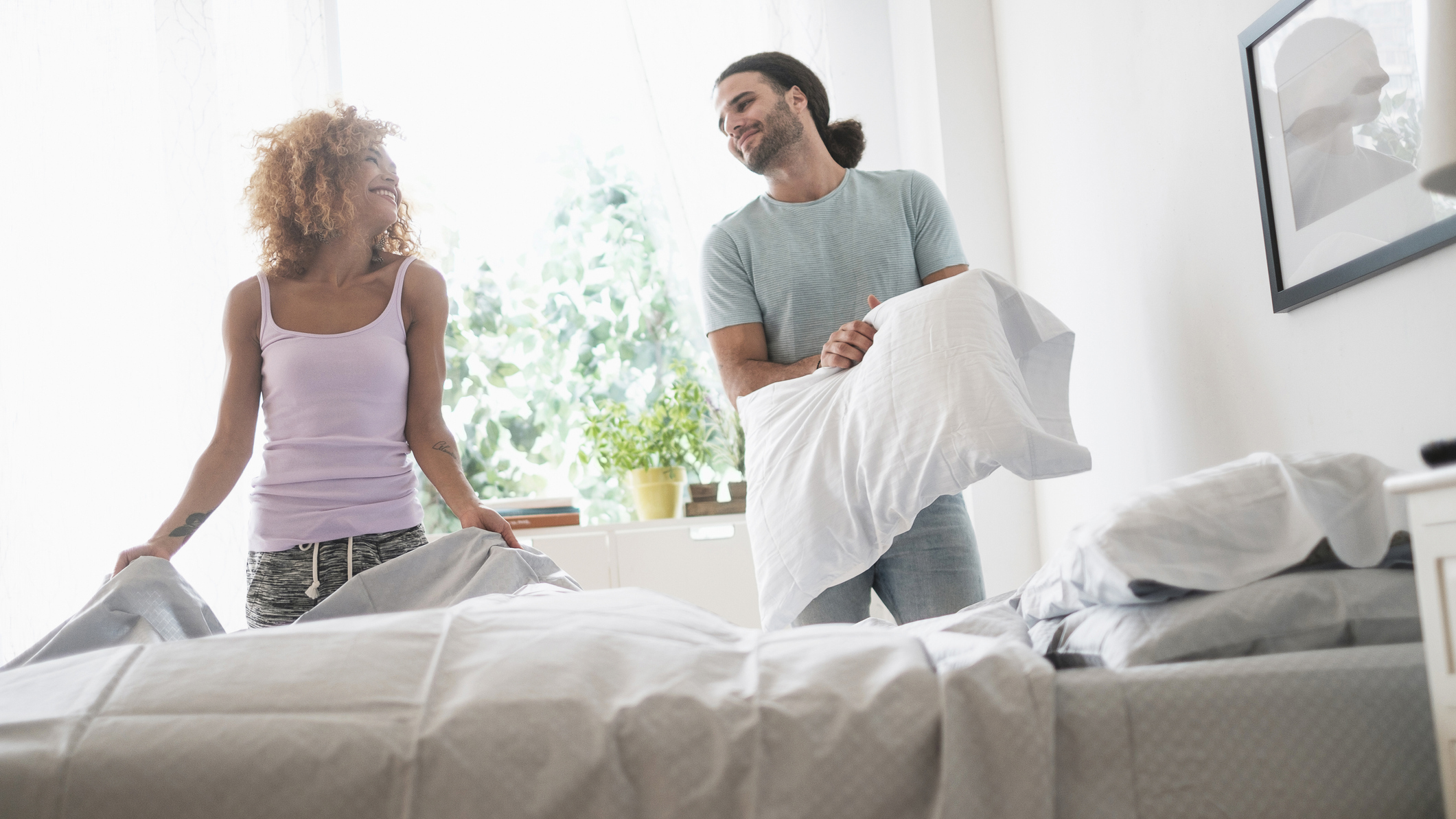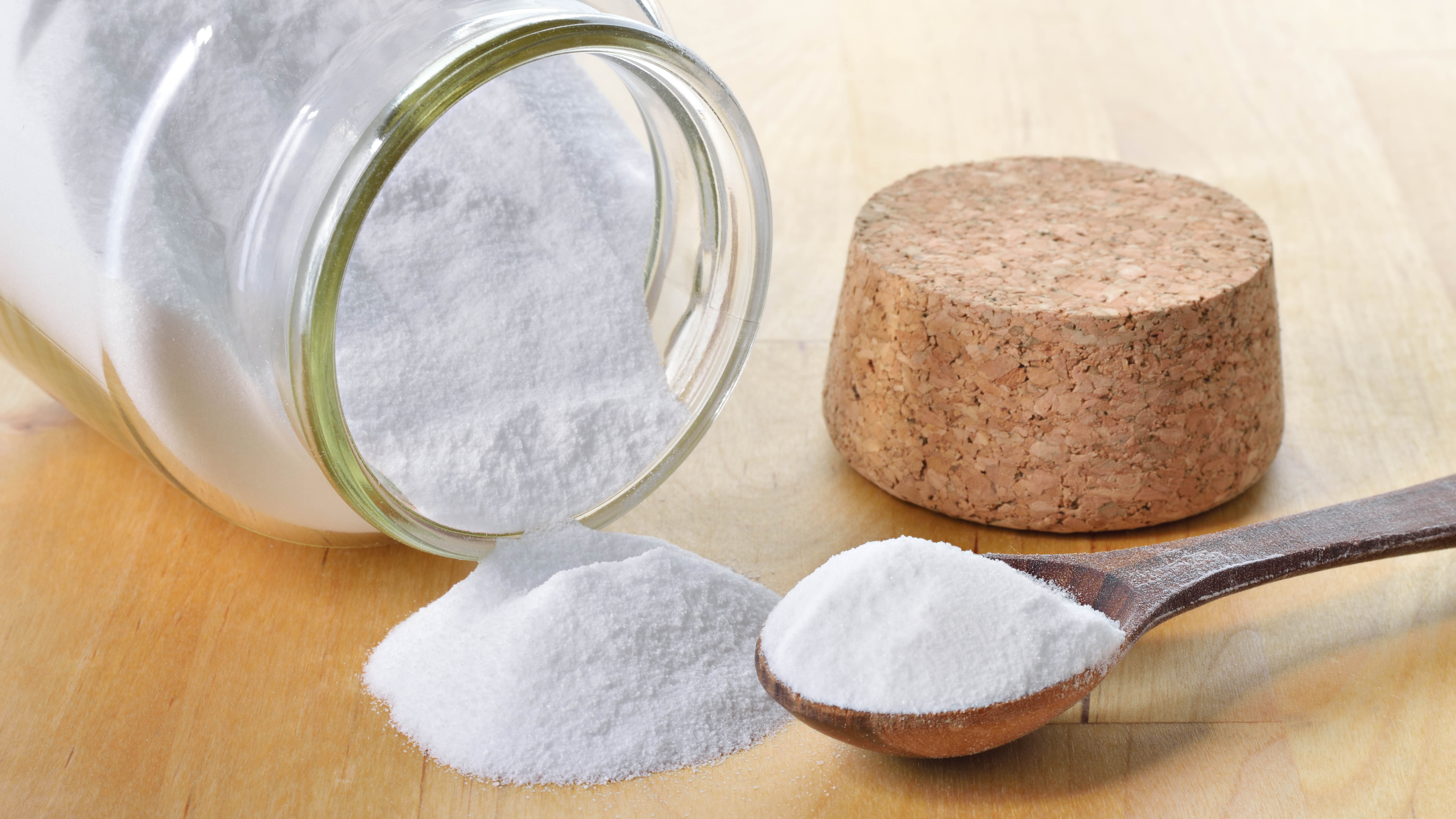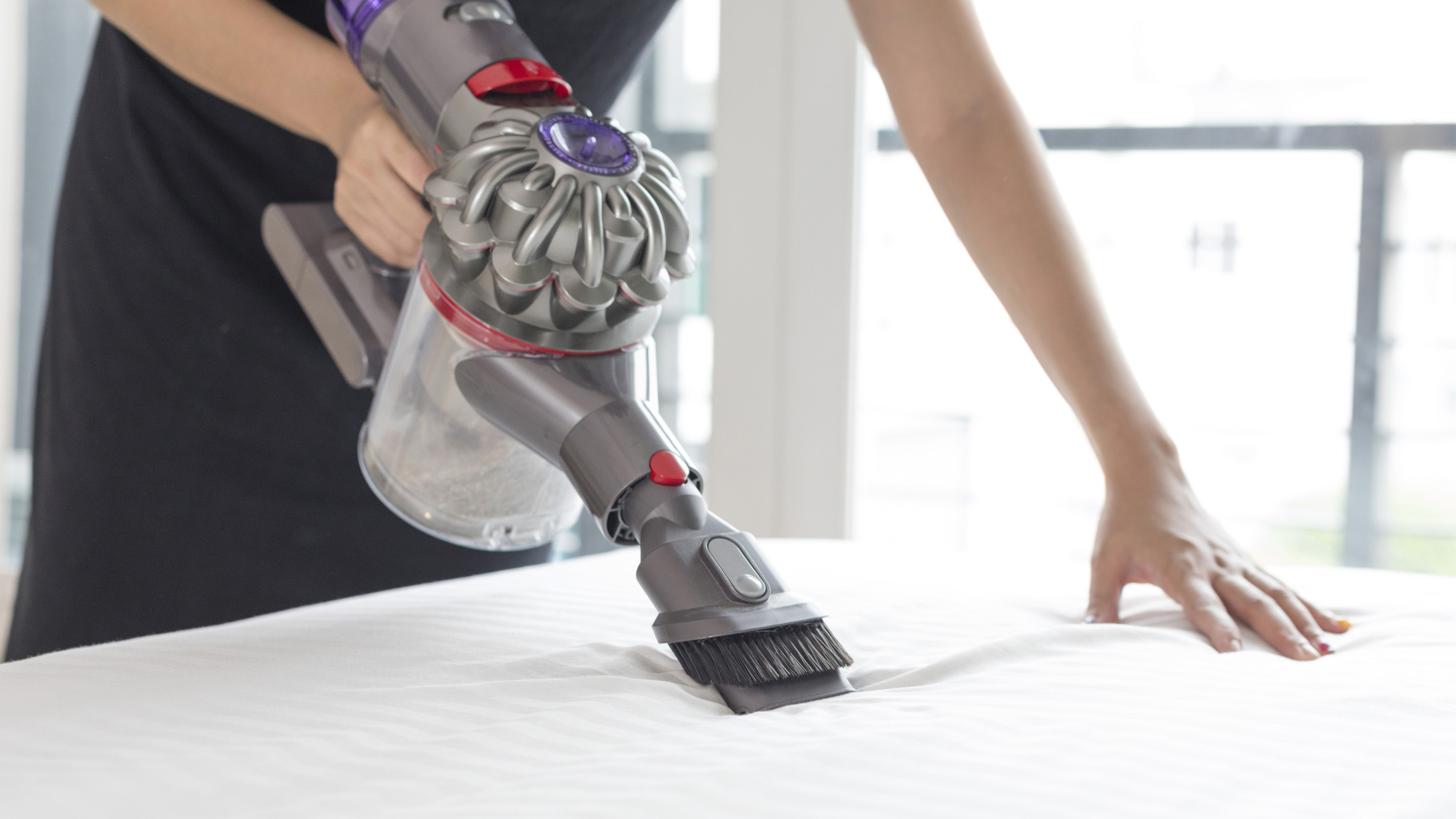7 expert tips for vacuuming a mattress — get rid of bed bugs, dust mites and smells
We asked the pros how to vacuum your mattress for proper sleep hygiene

Want to have a healthy clean sleep night after night? Vacuuming your mattress regularly is the one way you can get rid of bed bugs, dust mites and bad odor to ensure an uninterrupted sleep.
Even if you've invested in one this year's best mattresses with hypoallergenic materials, they're not immune to bed bugs and dust mites. This is why vacuuming your mattress should be a habit you take up to ensure you're practising great sleep hygiene.
For all the top mattress vacuuming tips, we reached out to experts Stephen Wales, founder and owner of Bespoke Pest Control, a UK based pest control company, and Georgios Liakopoulos, who has over two years experience as a Pest Franchisee at Fantastic Pest Control.
Based on their insights, we’ve rounded up seven key tips for vacuuming your mattress and getting rid of dust mites, bed bugs and more…
1. Vacuum your mattress weekly
Your mattress can easily become a breeding ground for dust mites and other allergens over time.
These microscopic pests thrive on the dead skin cells we naturally shed while sleeping. Their droppings can trigger allergy symptoms like itchy eyes and irritated skin.
To keep them at bay, vacuum your mattress once a week, ideally right after removing your sheets.
Get instant access to breaking news, the hottest reviews, great deals and helpful tips.
"While [vacuuming] can help remove bed bugs, eggs, and debris, bed bugs often hide in cracks, crevices, and deep inside the mattress," says Liakopolulos.

"The most effective way to address an infestation is to combine vacuuming with other methods, such as using pesticides, heat treatments, or contacting a professional pest control company."
Georgios Liakopoulos has over two years experience as a Pest Franchisee at Fantastic Pest Control, which sits under the Fantastic Services umbrella. Liakopoulos is highly skilled in a wide range of insect and rodent eradication and is passionate about helping eradicating pests from homes and businesses.
This helps get rid of the dust and dead skin cells before they settle deeper into the bed and cause long-term wear and tear.
Before embarking on the task, it's also wise to invest in one of the best vacuums for the job - Liakopoulos recommends one with a HEPA filter and brush attachment.
2. Don't forget the sides and headboard
Bed bug fecal matter (which looks like small dark spots), eggs measuring 1mm, shed skin, bloody stains and a musty smell are all pretty strong indications that bed bugs are dwelling in your mattress.
However, despite their name, bed bugs can also make your bed frame, duvet and pillows their home. “Bed bugs live in and around the host, they do not just live in or on the mattress,” explains Wales, who has over 20 years of pest control experience.
Stephen Wales is the founder and owner of Bespoke Pest Control, a UK based pest control company. After accruing more than two decades of experience as a pest control specialist, Wales now places an emphasis on preventative pest control measures, offering both a proactive and reactive pest control service.
“They can live in the bed frame, plug sockets, drawers, soft toys, behind pictures, in light fittings — basically anywhere with a gap big enough that they can hide behind or in. They can also live in sofas and chairs, so it’s not just a mattress or bedroom issue.”

Make sure to vacuum the sides of the mattress and your headboard too, if it's fabric. For wooden or metal bed frames, a quick wipe with a damp cloth will remove dust and debris.
Use a vacuum with an upholstery attachment to reach deep into the seams, corners and tufts where dust mites and bugs often like to hide. Take your time and go over each area at least twice to ensure your bed is clean and allergen-free.
3. Treat any mattress stains first
If you have stains on your mattress then you must tackle these before you start to vacuum. Stains appear for various reasons, but it’s usually a build-up of body oils and sweat that accumulate on the mattress while we sleep.
Accidents and spills can also cause stains; if they’re not treated, you may notice a foul odor. Some mattresses can even start to develop mold so it is worth learning how to spot mattress mold and deal with the issue quickly.

To spot treat stains easily:
- Make a natural cleaning solution using one cup of white vinegar, one cup of water and a small dash of laundry or dish detergent.
- Combine these in a spray bottle and spritz the stain. Taking a clean cloth or paper towel, blot at the stain until you start to see it lift.
- If the stain is built-in, then leave it to soak on the area for around 15 minutes.
- You can repeat this step as many times as you need to but be mindful not to soak the area as this can cause damage to the mattress.
4. Don't use excessive force
It might seem like pressing your vacuum firmly into your mattress will give it a deeper clean, but this can actually do more harm than good.
Many mattresses especially with memory foam or quilted pillow-tops— are more delicate than they appear. Applying too much pressure or using high suction can compress the internal layers, leading to a loss of shape and support over time.
This can even create an uneven sleeping surface with dips and lumps which will significantly affect your posture during sleep, potentially causing joint or back pain. Harsh vacuuming can also strain the stitching, increasing the risk of rips or tears.
The ideal method is to simply glide the vacuum over the surface using a light touch and go over each area multiple times to effectively remove dust and mites without damage.
5. Use baking soda to get rid of smells
With so many different sprays and potions on the market these days it can be tempting to freshen up your mattress surface by squirting shop bought chemicals.
But what if there's a natural route you can take instead? Baking soda is a great way to remove funky odors from your mattress, leaving it feeling fresh and clean.

All you need to do to is mix together some baking powder and a couple of drops of your favourite essential oils. We love lavender and lemon together because it’s calming and relaxing while also smelling super fresh.
After you strip your bed give your mattress a quick run over with the vacuum cleaning, then using a flour sifter for even coverage spread the baking powder over the surface of your mattress and leave for around two to three hours.
After you’ve let it sit, vacuum it away and you’re left with a fresh smelling mattress.
6. Empty the vacuum of dust mites and bed bugs
When you’re done with vacuuming your mattress you don’t want to risk spreading dust mites and bed bugs elsewhere in your home, so always empty your cleaner.
If you think you have signs of bed bugs in your mattress, immediately take your vacuum cleaner outside and empty the canister into a bag that can be fully sealed.

This, says Wales, is to prevent bed bugs from living inside your vacuum. Don't do this indoors as bed bugs are prolific and they will infest the rest of your home (such as sofas, carpets and chairs) rapidly.
You will also need to deep clean your vacuum cleaner because you don’t want to risk leaving behind any hidden bed bugs or their eggs.
If you have a bagged vacuum, replace the bag. If you have a bagless vacuum cleaner, soak the canister and any removable filters in hot, soapy water for around 15 minutes. Leave to dry thoroughly before reassembling and using again.
7. For bed bugs, try a professional mattress clean
If you’re struggling with a bed bug infestation, vacuuming your mattress alone won't solve the problem. While it may help remove bed bugs, eggs and any debris, it won’t always be enough to completely eliminate them.
Bed bugs hate heat so if you think you have an infestation, strip your bedding and place on a hot wash, after first consulting with product care instructions.
In addition to vacuuming your mattress thoroughly, Liakopoulos advises those with an existing bed bug infestation to invest in a steam cleaner.

"Steam cleaning your mattress can kill bed bugs and their eggs," says Liakopoulos. "Steam cleaners with mattress attachments are suitable for mattress cleaning."
However, be aware that for some bed types, for example, memory foam mattresses, this method isn’t suitable.
The best way to tackle a bed bug infestation, according to both Wales and Liakopoulos, is to combine vacuuming with other methods such as such as using pesticides, heat treatments or contacting a professional pest control specialist.
How often should you vacuum a mattress?
How often you vacuum your mattress depends on a couple of factors including whether you have allergies, if you sleep hot or sweat a lot at night, if you share your bed with your pets or if you use a mattress protector or mattress encasement.
Although, according to Wales, you should generally vacuum your mattress at least once a month.
It's a good idea if you can get into a regular cleaning routine when it comes to your mattress and you'll find plenty of tips in our how to clean your mattress guide.
Vacuuming your mattress every week is important during spring and summer when there's an increase of allergens and pollen in the air
While vacuuming once a month is the rule of thumb, we suggest that you vacuum the surface weekly. You can time this to coincide with changing your bedsheets, that way you also keep on top of the last time you vacuumed it too.
Vacuuming your mattress weekly is especially important during spring and summer when there is an increase of allergens and pollen in the air. In fact, it's a key step in our guide on how to sleep with hay fever.
And if you’re a hot sleeper you may find that you sweat more so regularly vacuuming will help protect your mattress against staining and odors.
If you use a bed protector or encasement then you can usually machine wash these so they can go in whilst you wash your sheets and it means that you don’t need to vacuum your mattress quite as often.

Can you vacuum any type of mattress?
It is generally safe to vacuum any type of mattress however if you want to avoid doing any damage to the fabrics or the stitching it is worth using your vacuum on the lowest possible suction.
As we said, excessive force can cause damage to your mattress surface so use gentle strokes to clean the surface and repeat the process to make sure that you’ve reached all areas.
Some organic mattresses contain natural fibers that can't be vacuumed, such as wool. If you want to clean an organic mattress, use a soft bristle brush.
Also, you shouldn’t use a vacuum cleaner on a waterbed as the suction could damage it and you’ll end up with a flooded bedroom.
Should you use a separate vacuum for your mattress?
You don’t need to use a separate vacuum for your mattress. A regular household vacuum is perfectly fine especially if you have an upholstery attachment.
These have a smaller nozzle which are designed for getting into the nooks and crannies of a mattress and this is especially important for keeping on top of dust mites who like to hide in the seams and crevices.

You may want to consider a separate vacuum if you don’t want to risk spreading dust mites to other parts of your home.
This is especially true if you have a severe allergy or weakened immune system, but generally, this could be handled by emptying and cleaning the vacuum each time it’s been in use.
The other reason why you may want to consider a separate machine is if your vacuum doesn’t have a handheld option.
If you’re working on a larger area such as a king or cal king mattress then a handheld vacuum will allow you to cover more of an area with ease.
Should you vacuum a mattress topper?
As the name suggests, a topper is a protective and comfort-enhancing layer which goes over your mattress.
With regular use, this too can collect dead skin, sweat, body oils, dust and other debris, so regular vacuuming is key to keeping your sleep space fresh and hygienic.
If you use a topper, then aim to vacuum this more frequently than your main mattress. Focus on seams, edges and tufted areas where build-up often hides.
Many toppers come with removable covers that can be machine washed. Always check the label first, as some materials require specific washing methods to avoid damage and preserve comfort and durability.
How to protect a mattress after vacuuming it
One of the most effective ways to keep your mattress clean and hygienic after vacuuming it is to invest in one of the best mattress protectors.
This one underrated and inexpensive bedding product provides a barrier between you and the surface of your mattress protecting it from spills, accidents, body fluids, dust mites, bed bugs and anything else you want to subject your sleeping surface too.
A mattress protector helps maintain a dry, clean sleep surface and plays a key role in prolonging the lifespan of your bed.

In fact, many mattress manufacturers specify that you should use one on your mattress in order to comply with the warranty conditions.
Even though it comes in a variety of styles and forms, our Sleep Editor, Claire Davies, recommends investing in a mattress encasement for additional protection from bed bugs.
“A fully zippered mattress encasement is the best way to prevent bed bugs in your mattress,” explains Davies.
“Whereas normal mattress protectors just cover the top and sides, a mattress encasement covers the top, bottom and sides. It then zips shut, so bed bugs have zero chance of reaching your mattress.”

Rachael has a keen interest in all things sleep, including her expert knowledge on mattress cleaning, providing readers with the best hacks and tips to keep their beds clean, as well as trying out the latest viral cleaning products. Rachael also reports on leading mattress brands such as Helix, Saatva and Nectar, writing articles designed to help readers understand what they need from a new bed. She also enjoys reviewing home, travel and tech gadgets, especially anything that has been designed to make life easier like smart home gadgets. During the last 15 years, Rachael has contributed to various publications including Tom’s Guide, Creative Bloq, The Independent, The Spectator, Daily Express and more.
You must confirm your public display name before commenting
Please logout and then login again, you will then be prompted to enter your display name.
